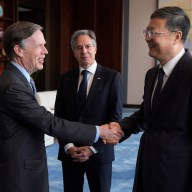WASHINGTON – The missile test-fired by Iran is similar in design and range to missiles it has launched in previous years, but it is too early to tell if it demonstrated any new capabilities, U.S. defence and intelligence officials said Wednesday.
Defence Secretary Robert Gates provided the first official U.S. confirmation of the Iranian launch, briefly telling a House committee about the test nearly eight hours after it was announced by Iranian President Mahmoud Ahmadinejad.
“The information that I have read indicates that it was a successful flight test,” Gates told the House Appropriations Committee. “The missile will have a range of approximately 2,000 to 2,500 kilometres.”
Gates added that “because of some of the problems they’ve had with their engines we think at least at this stage of the testing we think its probably closer to the lower end of that range. Whether it hit the target that it was intended for, I have not seen any information on that.”
U.S. officials said that government analysts and other specialists were still assessing information from the launch, including the missile’s range, fuel and other details.
Iran’s announcement comes less than a month before Iran’s presidential election and just two days after President Barack Obama declared a readiness to seek deeper international sanctions against Tehran if it did not respond positively to U.S. attempts to open negotiations on its nuclear program.
Ahmadinejad said the launch was a test-firing of a new advanced missile with a range of about 2,000 kilometres, capable of reaching Israel, U.S. bases in the Mideast, and parts of Europe.
But both U.S. government officials and independent American missile experts said Wednesday that the Iranian missile did not appear to be a new model.
One defence official said that the missile appeared to be consistent in appearance and performance with Tehran’s Ashura missile, a model previously tested more than a year ago.
“It’s too soon to say if this is any change in capabilities,” the official said.
The Iranian government called the missile launched Wednesday a Sejjil, a version of another model launched last summer.
Charles Vick, a senior technical analyst for GlobalSecurity.org, analyzed photos and videotape of the launch released by Iran.
“I’m not all that impressed,” Vick said. “It’s just another test that confirms they’ve got the system that was operational last summer.”
“Obviously, we’ve seen reports,” presidential press secretary Robert Gibbs said. “You all know the concerns that the president has about Iran’s missile development programs …. and the strong belief that the pursuit of those programs does not strengthen the security of Iran but instead make them less safe.”
“Obviously, the president has been long concerned about it,” he said. Gibbs noted that Obama and visiting Israeli Prime Minister Benjamin Netanyahu had “both agreed on Monday that engaging the people and the leaders of the Islamic Republic of Iran, something that hasn’t been tried for the past many years, is something that makes sense.”
Secretary of State Hillary Rodham Clinton, appearing Wednesday morning before the Senate Appropriations Committee, said nothing directly about the Iranian launch when Senator Patrick Leahy (D-Vt.) raised the issue during questioning.
But Clinton did discuss the subject generally, saying that a nuclear-armed Iran would “spark an arms race” in the Middle East.
She referred to a host of threats to the United States that she said are “daunting.” And Clinton reiterated that the administration opposes Iran getting a nuclear weapons capability and that it is relying for now on diplomatic pressure to stop it.
Pentagon spokesman Bryan Whitman added that “Iran is at a bit of a crossroads. They have a choice to make. They can either continue on this path of continued destabilization in the region or they can decide that they want to pursue relationships with the counties in the region and the United States that are more normalized.”
















